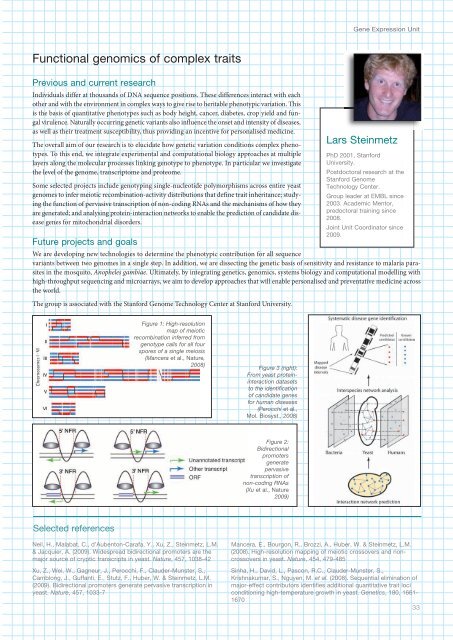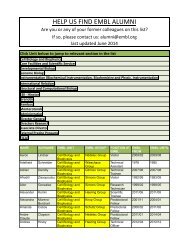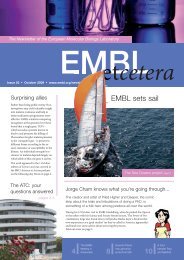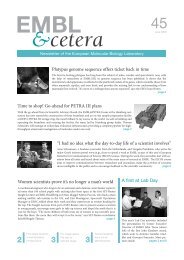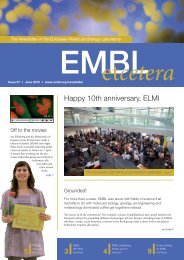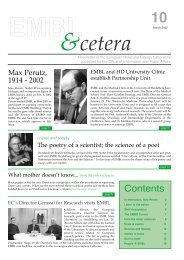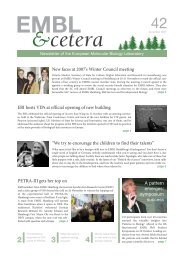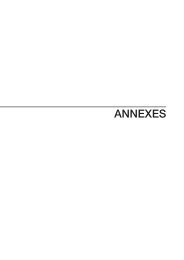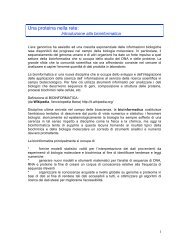Gene Expression UnitFunctional genomics of complex traitsPrevious and current researchIndividuals differ at thousands of DNA sequence positions. These differences interact with eachother and with the environment in complex ways to give rise to heritable phenotypic variation. Thisis the basis of quantitative phenotypes such as body height, cancer, diabetes, crop yield and fungalvirulence. Naturally occurring genetic variants also influence the onset and intensity of diseases,as well as their treatment susceptibility, thus providing an incentive for personalised medicine.The overall aim of our research is to elucidate how genetic variation conditions complex phenotypes.To this end, we integrate experimental and computational biology approaches at multiplelayers along the molecular processes linking genotype to phenotype. In particular we investigatethe level of the genome, transcriptome and proteome.Some selected projects include genotyping single-nucleotide polymorphisms across entire yeastgenomes to infer meiotic recombination-activity distributions that define trait inheritance; studyingthe function of pervasive transcription of non-coding RNAs and the mechanisms of how theyare generated; and analysing protein-interaction networks to enable the prediction of candidate diseasegenes for mitochondrial disorders.Future projects and goalsWe are developing new technologies to determine the phenotypic contribution for all sequencevariants between two genomes in a single step. In addition, we are dissecting the genetic basis of sensitivity and resistance to malaria parasitesin the mosquito, Anopheles gambiae. Ultimately, by integrating genetics, genomics, systems biology and computational modelling withhigh-throughput sequencing and microarrays, we aim to develop approaches that will enable personalised and preventative medicine acrossthe world.The group is associated with the Stanford Genome Technology Center at Stanford University.Lars SteinmetzPhD 2001, StanfordUniversity.Postdoctoral research at theStanford GenomeTechnology Center.Group leader at <strong>EMBL</strong> since2003. Academic Mentor,predoctoral training since2008.Joint Unit Coordinator since2009.Figure 1: High-resolutionmap of meioticrecombination inferred fromgenotype calls for all fourspores of a single meiosis(Mancera et al., Nature,2008)Figure 3 (right):From yeast proteininteractiondatasetsto the identificationof candidate genesfor human diseases(Perocchi et al.,Mol. Biosyst., 2008)Figure 2:Bidirectionalpromotersgeneratepervasivetranscription ofnon-coding RNAs(Xu et al., Nature2009)Selected referencesNeil, H., Malabat, C., d’Aubenton-Carafa, Y., Xu, Z., Steinmetz, L.M.& Jacquier, A. (2009). Widespread bidirectional promoters are themajor source of cryptic transcripts in yeast. Nature, 57, 1038-2Xu, Z., Wei, W., Gagneur, J., Perocchi, F., Clauder-Munster, S.,Camblong, J., Guffanti, E., Stutz, F., Huber, W. & Steinmetz, L.M.(2009). Bidirectional promoters generate pervasive transcription inyeast. Nature, 57, 1033-7Mancera, E., Bourgon, R., Brozzi, A., Huber, W. & Steinmetz, L.M.(2008). High-resolution mapping of meiotic crossovers and noncrossoversin yeast. Nature, 5, 79-85Sinha, H., David, L., Pascon, R.C., Clauder-Munster, S.,Krishnakumar, S., Nguyen, M. et al. (2008). Sequential elimination ofmajor-effect contributors identifies additional quantitative trait lociconditioning high-temperature growth in yeast. Genetics, 180, 1661-167033
<strong>EMBL</strong> Research at a Glance 2009Mechanisms of transcription regulation throughchromatinAsifa AkhtarPhD 1998, Imperial CancerResearch Fund, London.Postdoctoral research at<strong>EMBL</strong> and Adolf-Butenandt-Institut, Munich.Group leader at <strong>EMBL</strong> since2001.Previous and current researchDNA tightly packed together with histones into nucleosomes is not easily accessible to the enzymesthat use it as a template for transcription or replication. Consequently, remodelling of chromatinstructure may play an essential role in the regulation of gene expression. Structural changesin chromatin may also form the basis for dosage compensation mechanisms that have evolved toequalise levels of X-linked gene products between males and females. In humans, one of the twoX chromosomes in females is randomly inactivated by condensation of the chromosome into aBarr body, a process known as X-inactivation. In contrast, in Drosophila this is achieved by a twofold hyper-transcription of the genes on the male X chromosome. Genetic studies have identifieda number of factors that are important for dosage compensation in Drosophila, including five proteins(MSL1, MSL2, MSL3, MLE, MOF) and two non-coding RNAs (roX1 and roX2). The hyperactiveX is also specifically hyper-acetylated at histone H4, acetylation which is achieved by theMOF histone acetyl transferase.Our major goal is to study the epigenetic mechanisms underlying X-chromosome specific generegulation using Drosophila dosage compensation as a model system. More specifically, we are interested in addressing how the dosage compensationcomplex, composed of RNA and proteins (the MSL complex), gets targeted to the X chromosome. In addition, we are studying themechanism by which the MSL complex modulates X chromosomal transcriptional output.Future projects and goalsThe role of nuclear periphery in X chromosomalregulation. We have recently discovered theinvolvement of nuclear pore components in theregulation of dosage compensation in Drosophila.This work has raised several interesting questionsabout the role of genome organisation and generegulation, which we will continue to actively addressin the future. In addition to using functionalgenomic approaches, we plan to study in detail themechanism of nuclear pore/X chromosomal interactionby employing detail cell biology and biochemicalchromatin-based strategies. Thismultifaceted approach will be instrumental in futurestudies to decipher the mechanism of X chromosomalregulation by the MSL complex.Immunostaining of polytene chromosomes from salivary glands of male Drosophilausing antibodies directed against members of the dosage compensation complex(DCC). The figure shows that MSL-3 and MSL-2 co-localise specifically on hundreds ofsites on the male X chromosome. All the chromosomes are also stained with Hoechstto show staining of DNA. The position of the X chromosome is indicated by X.The role of non-coding RNA in dosage compensation. The involvement of non-coding RNAs as potential targeting molecules adds anotherlevel of complexity to chromatin regulation. Interestingly, the dosage compensation complex includes two non-coding roX RNAs. However,the mechanism by which these RNAs function is unknown. One of our future aims will be to elucidate how these interactions influencetranscription activation of the X-linked genes.The function of the mammalian MSL complex. There is a remarkable evolutionary conservation of all the known Drosophila dosage compensationcomplex members in mammals. In fact, we have recently purified the Drosophila and mammalian MSL complexes and shown thatthere is a high degree of conservation also at the biochemical level, implying a functional role for the mammalian MSL complex in gene regulationwhich we will continue to study.Selected referencesKind, J., Vaquerizas, J.M., Gebhardt, P., Gentzel, M., Luscombe,N.M., Bertone, P. & Akhtar, A. (2008). Genome-wide analysis revealsMOF as a key regulator of dosage compensation and geneexpression in Drosophila. Cell, 133, 813-828Kind, J. & Akhtar, A. (2007). Cotranscriptional recruitment of thedosage compensation complex to X-linked target genes. GenesDev., 21, 2030-200Legube, G., McWeeney, S.K., Lercher, M.J. & Akhtar, A. (2006). X-chromosome-wide profiling of MSL-1 distribution and dosagecompensation in Drosophila. Genes Dev., 20, 871-883Mendjan, S., Taipale, M., Kind, J., Holz, H., Gebhardt, P., Schelder,M., Vermeulen, M., Buscaino, A., Duncan, K., Mueller, J., Wilm, M.,Stunnenberg, H.G., Saumweber, H. & Akhtar, A. (2006). Nuclear porecomponents are involved in the transcriptional regulation of dosagecompensation in Drosophila. Mol. Cell, 21, 811-8233


